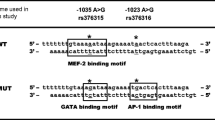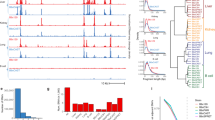Abstract
Genetic polymorphisms in the human solute carrier family 11 member 1 (SLC11A1) gene predispose to susceptibility to infectious/inflammatory diseases and cancer. Human susceptibility to these diseases exhibits allelic association with a polymorphic regulatory Z-DNA-forming microsatellite of a (GT/AC)n repeat. The carriage of different alleles may influence chromatin remodeling and accessibility by transcription factors. Of particular importance is the binding site for the Activating Protein 1 (AP-1) elements, (ATF-3 and c-Jun), adjacent to the 5′ sequence of the Z-DNA-forming polymorphism. The aim of the study was to characterize the transcriptional mechanisms controlling different alleles of SLC11A1 expression by ATF-3 and c-Jun. Allele 2, [T(GT)5AC(GT)5AC(GT)10GGCAGA(G)6], and Allele 3, [T(GT)5AC(GT)5AC(GT)9GGCAGA(G)6], were subcloned into the PGL2Basic vector. Transient transfections of THP-1 cells with the constructs, in the presence or absence of pATF-3 were preformed. Luciferase expression was determined. To document the recruitment of ATF-3 and c-Jun, to the polymorphic promoter alleles in vivo, we performed ChIP assays with transient transfected THP-1 cells treated with or without lipopolyssacharides. Our data documented that ATF-3 suppresses the transcriptional activation of Allele-3, and this suppression is enhanced in the presence of lipopolyssacharides. Our findings suggest that ATF-3 and c-Jun may influence heritable variation in SLC11A1-dependent innate resistance to infection and inflammation both within and between populations.





Similar content being viewed by others
References
Awomoyi A (2007) The human solute carrier family 11 member 1 protein (SLC11A1): linking infections, autoimmunity and cancer? FEMS Immunol Med Microbiol 49:324–329
Canonne-Hergaux F, Calafat J, Richer E, Cellier M, Grinstein S, Borregaard N, Gros P (2002) Expression and subcellular localization of NRAMP1 in human neutrophil granules. Blood 100:268–275
Searle S, Bright NA, Roach TI, Atkinson PG, Barton CH, Meloen RH, Blackwell JM (1998) Localisation of Nramp1 in macrophages: modulation with activation and infection. J Cell Sci 111:2855–2866
Atkinson PG, Barton CH (1998) Ectopic expression of Nramp1 in COS-1 cells modulates iron accumulation. FEBS Lett 425(2):239–242
Atkinson PG, Blackwell JM, Barton CH (1997) Nramp1 locus encodes a 65 kDa interferon-gamma-inducible protein in murine macrophages. Biochem J 325:779–786
Cellier M, Govoni G, Vidal S, Kwan T, Groulx N, Liu J, Sanchez F, Skamene E, Schurr E, Gros P (1994) Human natural resistance-associated macrophage protein: cDNA cloning, chromosomal mapping, genomic organization, and tissue-specific expression. J Exp Med 180:1741–1752
Shaw MA, Collins A, Peacock CS, Miller EN, Black GF, Sibthorpe D, Lins-Lainson Z, Shaw JJ, Ramos F, Silveira F, Blackwell JM (1997) Evidence that genetic susceptibility to Mycobacterium tuberculosis in a Brazilian population is under oligogenic control: linkage study of the candidate genes NRAMP1 and TNFA. Tuber Lung Dis 78:35–45
Marquet S, Sanchez FO, Arias M, Rodriguez J, Paris SC, Skamene E, Schurr E, Garcia LF (1999) Variants of the human NRAMP1 gene and altered human immunodeficiency virus infection susceptibility. J Infect Dis 180:1521–1525
Cervino AC, Lakiss S, Sow O, Hill AV (2002) Allelic association between the NRAMP1 gene and susceptibility to tuberculosis in Guinea–Conakry. Ann Hum Genet 64:507–512
Gao PS, Fujishima S, Mao XQ, Remus N, Kanda M, Enomoto T, Dake Y, Bottini N, Tabuchi M, Hasegawa N, Yamaguchi K, Tiemessen C, Hopkin JM, Shirakawa T, Kishi F (2000) Genetic variants of NRAMP1 and active tuberculosis in Japanese populations. Clin Genet 58:74–76
Meisner SJ, Mucklow S, Warner G, Sow SO, Lienhardt C, Hill AV (2001) Association of NRAMP1 polymorphism with leprosy type but not susceptibility to leprosy per se in West Africans. Am J Trop Med Hyg 65:733–735
Awomoyi AA, Marchant A, Howson JM, McAdam KP, Blackwell JM, Newport MJ (2002) Interleukin-10, polymorphism in SLC11A1 (formerly NRAMP1), and susceptibility to tuberculosis. J Infect Dis 186:1808–1814
Liu W, Cao WC, Zhang CY et al (2004) VDR and NRAMP1 gene polymorphisms in susceptibility to pulmonary tuberculosis among the Chinese Han population: a case–control study. Tuber Lung Dis 8:428–434
Singh A, Gaughan JP, Kashyap VK (2011) SLC11A1 and VDR gene variants and susceptibility to tuberculosis and disease progression in East India. Int J Tuber Lung Dis 15(11):1468–1474
Hofmeister A, Neibergs HL, Pokorny RM, Galanduik S (1997) The natural resistance associated macrophage protein gene is associated with Cohn’s disease. Surgery 122:173–179
Maliarik MJ, Chen KM, Sheffer RG (2000) The natural resistance associated macrophage protein gene in African Americans with sarcoidosis. Am J Respir Cell Mol Biol 22:672–675
Sanjeevi CB, Miller EN, Dabadghao P, Rumba I, Shtauvere A, Denisova A, Clayton D, Blackwell JM (2000) Polymorphism at NRAMP1 and D2S1471 loci associated with juvenile rheumatoid arthritis. Arthritis Rheum 43:1397–1404
Singal DP, Li J, Zhu Y, Zhang G (2000) NRAMP1 gene polymorphism in patients with rheumatoid arthritis. Tissue Antigens 55:44–47
Yang YS, Kim SJ, Kim JW, Koh EM (2000) NRAMP1 gene polymorphisms in patients with rheumatoid arthritis in Koreans. J Korean Med Sci 15:83–87
Kojima Y, Kinouchi Y, Takahashi S, Negoro K, Hiwatashi N, Shimosegawa T (2001) Inflammatory bowel disease is associated with a novel promoter polymorphism of natural resistance-associated macrophage protein 1 (NRAMP1) gene. Tissue Antigens 58:379–384
Ouchi K, Suzuki Y, Shirakawa T, Kishi F (2003) Polymorphism of SLC11A1 (formerly NRAMP1) gene confers susceptibility to Kawasaki disease. J Infect Dis 87:326–329
Gazouli M, Koundourakis A, Ikonomopoulos J, Gialafos EJ, Papaconstantinou I, Nasioulas G, Lukas JC, Gorgoulis VG (2007) The functional polymorphisms of NRAMP1 gene in Greeks with sarcoidosis. Sarcoidosis Vasc Diffuse Lung Dis 24:153–154
Kotze MJ, de Villiers JN, Rooney RN, Grobbelaar JJ, Mansvelt EP, Bouwens CS, Carr J, Stander I, du Plessis L (2001) Analysis of the NRAMP1 gene implicated in iron transport: association with multiple sclerosis and age effects. Blood Cells Mol Dis 27:44–53
Zaahl MG, Warnich L, Victor TC, Kotze MJ (2005) Association of functional polymorphisms of SLC11A1 with risk of esophageal cancer in the South African colored population. Cancer Genet Cytogenet 159:48–52
Bayele HK, Peyssonnaux C, Giatromanolaki A, Arrais-Silva WW, Mohamed HS, Collins H, Giorgio S, Koukourakis M, Johnson RS, Blackwell JM, Nizet V, Srai SK (2007) HIF-1 regulates heritable variation and allele expression phenotypes of the macrophage immune response gene SLC11A1 from a Z-DNA forming microsatellite. Blood 110:3039–3048
Richer E, Campion CG, Dabbas B, White JH, Cellier MF (2008) Transcription factors Sp1 and C/EBP regulate NRAMP1 gene expression. FEBS J 275:5074–5089
Yong Zhong Xu, Thuraisingam Thusanth, Marino Rafael, Radzioch Danuta (2011) Recruitment of SWI/SNF Complex is required for trancriptional activation of the SLC11A1 gene during macrophage differentiation of HL-60 cells. J Biol Chem 286:12839–12849
Hai T, Wolfgang CD, Marsee DK, Allen AE, Sivaprasad U (1999) ATF3 and stress responses. Gene Expr 7:321–335
Ha SC, Lowenhaupt K, Rich A, Kim YG, Kim KK (2005) Crystal structure of a junction between B-DNA and Z-DNA reveals two extruded bases. Nature 437:1183–1186
Liu H, Mulholland N, Fu H, Zhao K (2006) Co-operative activity of BRG1 and Z-DNA formation in chromatin remodelling. Mol Cell Biol 26:2550–2559
Angel P, Baumann I, Stein B, Delius H, Rahmsdorf HJ, Herrlich P (1987) 12-O-tetradecanoyl-phorbol-13-acetate induction of the human collagenase gene is mediated by an inducible enhancer element located in the 5′-flanking region. Mol Cell Biol 7:2256–2266
Hai T (2006) The ATF transcription factors in cellular adaptive responses. In: Ma J (ed) Gene expression and regulation. Higher Education Press, Beijing, pp 322–333
Hai T, Curran T (1991) Cross-family dimerization of transcription factors Fos/Jun and ATF/CREB alters DNA binding specificity. Proc Natl Acad Sci USA 88:3720–3724
Zaahl MG, Robson KJH, Warnich L, Kotze MJ (2004) Expression of the SLC11A1 (NRAMP1) 5 V-(GT)n repeat: opposite effect in the presence of 237C → T. Blood Cells Mol Dis 33:45–50
Rich A, Nordheim A, Wang AHJ (1984) The chemistry and biology of left-handed Z-DNA. Annu Rev Biochem 53:791–846
Herbert A, Rich A (1999) Left-handed Z-DNA: structure and function. Genetica 106:37–47
Schroth, Chou P-J, Shing HoP (1992) Mapping Z-DNA in the human genome. J Biol Chem 267:11846–11855
Rothenburg S, Koch-Nolte F, Haag F (2001) DNA methylation and Z-DNA formation as mediators of quantitative differences in the expression of alleles. Immunol Rev 184:286–298
Oh DB, Kim YG, Rich A (2002) Z-DNA-binding proteins can act as potent effectors of gene expression in vivo. Proc Natl Acad Sci USA 99:16666–16671
Ha SC, Lokanath NK, Van Quyen D (2004) A poxvirus protein forms a complex with left-handed Z-DNA: crystal structure of a Yatapoxvirus Z_ bound to DNA. Proc Natl Acad Sci USA 101:14367–14372
Hammock EA, Young LJ (2005) Microsatellite instability generates diversity in brain and sociobehavioral traits. Science 308:1630–1634
Boehlk S, Fessele S, Mojaat A, Miyamoto NG, Werner T, Nelson EL, Schlöndorff D, Nelson PJ (2000) ATF and Jun transcription factors, acting through an Ets/CRE promoter module, mediate lipopolysaccharide inducibility of the chemokine RANTES in monocytic Mono Mac 6 cells. Eur J Immunol 30:1102–1112
Gilchrist M, Thorsson V, Li B, Rust AG, Korb M, Roach JC, Kennedy K, Hai T, Bolouri H, Aderem A (2006) Systems biology approaches identify ATF3 as a negative regulator of Toll-like receptor 4. Nature 441:173–178
Blackwell JM, Searle S, Mohamed H, White JK (2003) Divalent cation transport and susceptibility to infectious and autoimmune disease: continuation of the Ity/Lsh/Bcg/Nramp1/Slc11a1 gene story. Immunol Lett 85:197–203
Nagai, Akashi S, Nagafuku M, Ogata M, Iwakura Y, Akira S, Kitamura T, Kosugi A, Kimoto M, Miyake K (2002) Essential role of MD-2 in LPS responsiveness and TLR4 distribution. Nat Immunol 3(7):667–672
Hambleton J, Weinstein SL, Lem L, DeFranco AL (1996) Activation of c-Jun N-terminal kinase in bacterial lipopolysaccharide-stimulated macrophages. Proc Natl Acad Sci USA 93(7):2774–2778
Hsu JC, Bravo R, Taub R (1992) Interactions among LRF-1, JunB, c-Jun, and c-Fos define a regulatory program in the G1 phase of liver regeneration. Mol Cell Biol 12:4654–4665
Chen BP, Wolfgang CD, Hai T (1996) Analysis of ATF3, a tran- scription factor induced b yphysiological stresses and modulated by gadd153/Chop10. Mol Cell Biol 16:1157–1168
Yin T, Sandhu G, Wolfgang CD, Burrier A, Webb RL, Rigel DF, Hai T, Whelan J (1997) Tissue- specific pattern of stress kinase activation in ischemic/reperfused heart and kidney. J Biol Chem 272:19943–19950
Ameri K, Hammond EM, Culmsee C, Raida M, Katschinski DM, Wenger RH, Wagner E, Davis RJ, Hai T, Denko N, Harris AL (1996) Induction of activating transcription factor 3 by anoxia is independent of p53 and the hypoxic HIF signaling pathway. Oncogene 26:284–289
Lerner A, Clayton LK, Mizoguchi E, Ghendler Y, van EW, Koyasu S, Bhan AK, Reinherz EL (1996) Cross-linking of T-cell receptors on double-positive thymocytes induces a cytokine-mediated stromal activation process linked to cell death. EMBO J 15:5876–5887
Kim JY, Song EH, Lee S, Lim JH, Choi JS, Koh IU, Song J, Kim WH (2010) The induction of STAT1 gene by activating transcription factor 3 contributes to pancreatic beta- cell apoptosis and its dysfunction in streptozotocin-treated mice. Cell Signal 22:1669–1680
Liu G, Su L, Hao X, Zhong N, Zhong D, Singhal S, Liu X (2011) Salermide upregulates death receptor 5 expression through the ATF4-ATF3-CHOP axis and leads to apoptosis in human cancer cells. J Cell Mol Med. doi:10.1111/j.1582-4934.2011.01401.x
Yan C, Lu D, Hai T, Boyd DD (2005) Activating transcription factor 3, a stress sensor, activates p53 by blocking its ubiquitination. EMBOJ 24:2425–2435
Pearson AG, Gray CW, Pearson JF, Greenwood JM, During MJ, Dragunow M (2003) ATF3 enhances c-Jun- mediated neurite sprouting. Brain Res Mol Brain Res 120:38–45
Hunt D, Raivich G, Anderson PN (2012) Activating transcription factor 3 and the nervous system. Front Mol Neurosci 5:7
Author information
Authors and Affiliations
Corresponding author
Rights and permissions
About this article
Cite this article
Taka, S., Gazouli, M., Politis, P.K. et al. Transcription factor ATF-3 regulates allele variation phenotypes of the human SLC11A1 gene. Mol Biol Rep 40, 2263–2271 (2013). https://doi.org/10.1007/s11033-012-2289-1
Received:
Accepted:
Published:
Issue Date:
DOI: https://doi.org/10.1007/s11033-012-2289-1




